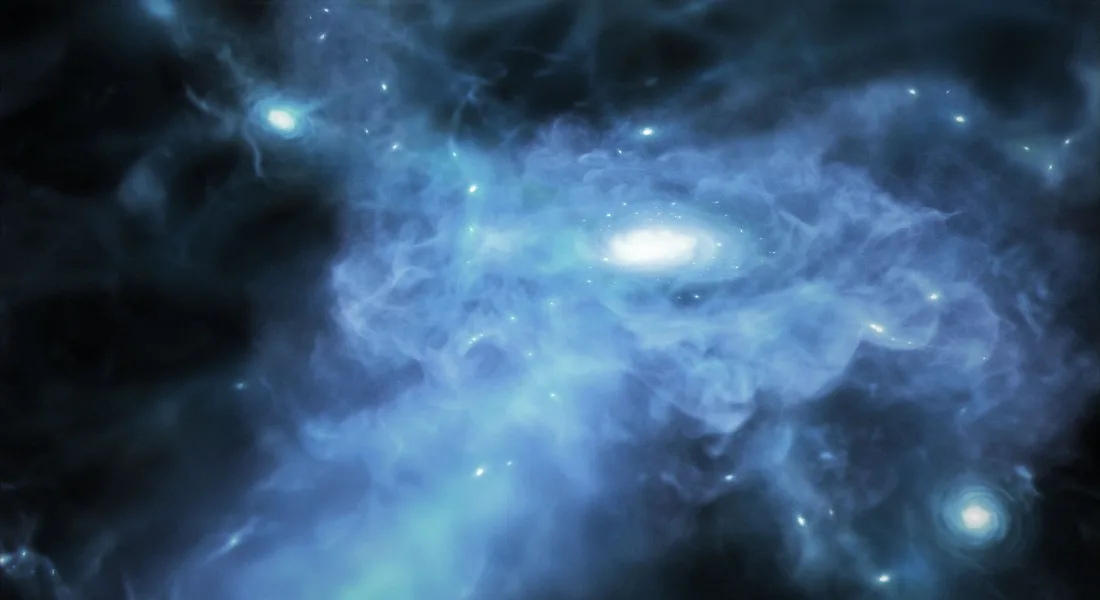Researchers from the University of Copenhagen’s Niels Bohr Institute have used the James Webb Space Telescope to observe the formation of three of the universe’s earliest galaxies, dating back over 13 billion years. This marks the first time such a formation has been directly witnessed. The team, led by Assistant Professor Kasper Elm Heintz, used the telescope’s infrared spectrograph capabilities to measure light from these galaxies, distinguishing them from other gas. The findings, published in the journal Science, contribute to our understanding of the universe’s origins. The team plans to apply for more observation time with the telescope to further their research.
Observing the Birth of the Universe’s Earliest Galaxies
For the first time in the history of astronomy, researchers at the Niels Bohr Institute have observed the formation of three of the universe’s earliest galaxies, dating back between 13.3 and 13.4 billion years ago. This groundbreaking discovery was made possible by the James Webb Space Telescope, which provided the first ‘live observations’ of galaxies in their formative stages.
The telescope enabled researchers to detect signals from large amounts of gas accumulating and accreting onto a mini-galaxy in the process of formation. This observation aligns with theories and computer simulations of galaxy formation, but it is the first time it has been directly witnessed. The study, led by Assistant Professor Kasper Elm Heintz, has been published in the scientific journal Science.
The Methodology Behind the Discovery
The researchers were able to measure the formation of the universe’s first galaxies by using sophisticated models of how light from these galaxies was absorbed by the neutral gas located in and around them, a transition known as the Lyman-alpha transition. By measuring the light, the researchers were able to distinguish gas from the newly formed galaxies from other gas. These measurements were only possible thanks to the James Webb Space Telescope’s incredibly sensitive infrared spectrograph capabilities.
The researchers estimate the birth of the three galaxies to have occurred roughly 400-600 million years after the Big Bang, the explosion that began it all. This corresponds to galaxies forming during the first three to four percent of the universe’s 13.8-billion-year overall lifetime.
The Early Universe and the Birth of Galaxies
Shortly after the Big Bang, the universe was an enormous opaque gas of hydrogen atoms. The first stars formed a few hundred million years after the Big Bang, before stars and gas began to coalesce into galaxies. This process is what the researchers have begun to observe in their study.
The birth of galaxies took place at a time in the history of the universe known as the Epoch of Reionization, when the energy and light of some of the first galaxies broke through the mists of hydrogen gas. The researchers captured these large amounts of hydrogen gas using the James Webb Space Telescope’s infrared vision. This is the most distant measurement of the cold, neutral hydrogen gas, which is the building block of the stars and galaxies, discovered by scientific researchers to date.
Understanding the Early Universe
The universe began its “life” about 13.8 billion years ago in an enormous explosion – the Big Bang. This event gave rise to an abundance of subatomic particles such as quarks and electrons. These particles aggregated to form protons and neutrons, which later coalesced into atomic nuclei. Roughly 380,000 years after the Big Bang, electrons began to orbit atomic nuclei, and the simplest atoms of the universe gradually formed.
The first stars were formed after a few hundred million years. And within the hearts of these stars, the larger and more complex atoms that we have around us were formed. Later, stars coalesced into galaxies. The oldest galaxies known to us were formed about 3-400 million years after the Big Bang. Our own solar system came into being about 4.6 billion years ago – more than 9 billion years after the Big Bang.
The Future of Galaxy Formation Research
The research team, led by Kasper Elm Heintz, in close collaboration with research colleagues Darach Watson, Gabriel Brammer and PhD student Simone Vejlgaard from the Cosmic Dawn Center at the University of Copenhagen’s Niels Bohr Institute, has already applied for more observation time with the James Webb Space Telescope. They hope to expand upon their new result and learn more about the earliest epoch in the formation of galaxies.
The new knowledge contributes to answering one of humanity’s most basic questions: “Where do we come from?”. The researchers aim to shed light on the moment that some of the universe’s first structures were created and investigate this process further, in hopes of piecing together more of the puzzle of our origins. The Danish portion of the research is funded by the Danish National Research Foundation and the Carlsberg Foundation.
External Link: Click Here For More

